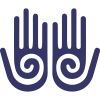Here is a shocking truth: you may boast a lovely “six pack” but that doesn’t mean you are strong! Your secret weapon for a strong and stable core cannot be exhibited on the beach.
When it comes to abdominal muscles, most people fixate on the iconic “six-pack” which is the domain of a muscle called Rectus Abdominis. But there’s a hidden hero lurking beneath, often neglected but crucial for true core strength and stability: the Transverse Abdominis (TrA).
Unveiling the Core
Think of your core as your body’s powerhouse, it’s not just about aesthetics. It’s the network of muscles deep within your torso, responsible for posture, stability, and protecting your internal organs. The core doesn’t just look good; it prevents back pain, improves athletic performance, and enhances everyday activities. If your core muscles are weak or do not function properly you may have trouble moving smoothly and gracefully as well as balancing and your general strength diminishes.
Our core is our physical, emotional, and energetic centre. It supports our spine, our posture, our gate. Here is where our centre of balance lies.
The Superstar: Transverse Abdominis
Nested beneath the obliques and rectus abdominis, the TrA is like the core’s superhero in disguise. Its fibers run horizontally, like a natural girdle, providing internal support and compression. Unlike crunches that target the “show muscles,” engaging the TrA is subtle but essential.
Why is the TrA so important?
- Corset muscle: It’s a 360 degrees of muscle and connective tissue – from ribcage and spine to pubic bone and pelvis. So when you engage your core, you are not only flattening your belly, you are engaging 360 degrees of muscle fibre.
- Stability King: Because it acts as a corset, it is stabilizing your spine and pelvis during movement, preventing injuries and improving balance.
- Posture Powerhouse: A strong TrA pulls your belly button inwards, promoting good posture and reducing slouching.
- Internal Organ Guardian: It holds your organs in place, preventing hernias and aiding in functions like coughing and childbirth.
- Athletic Advantage: Improved core stability from a strong TrA translates to better performance in various sports.
How to Tap into Your TrA Power with Yoga:
You don’t need fancy equipment or crunches to activate your TrA. Yoga does a great job in connecting to it, engaging and gently toning it. Here is how:
- Breathing: The Transverse Abdominis is closely connected to your respiratory diaphragm and your breathing. There are many breathing techniques used in yoga that can be used to feel this muscle and to tap into it’s power.
- Simple and accessible movement: There are very simple movements in yoga that can be done by everyone and are great for core stability and integration: pelvic tilts, supine poses that challenge the core by moving the legs and arms, etc. You can basically work your core and Transvese Abdominis standing, sitting or lying down.
- Yoga poses: All Plank variations are great for your TrA. As well as Bird-dogs of all kinds and other poses which require core stability without excessive movement.
In conclusion, as you explore the world of yoga with a focus on core stability and the ever-important Transverse Abdominis, remember that this journey is not about achieving a specific pose or reaching some predefined level of “perfect.” It’s about discovering the power and potential that lies within your own body.
With each mindful breath and intentional movement, you’re building strength, stability, and a deeper connection with your core. You’ll begin to notice improvements in your posture, reduced back pain, and a newfound sense of confidence in your everyday movements.
Related articles:
What’s wrong with crunches and is there a better way to train the abdominals
5 benefits from yoga that you might be missing out on now
Photo by Tim Mossholder on Unsplash



